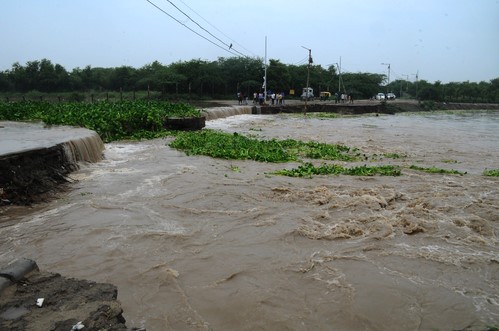Mumbai: This week, several north Indian states have been clobbered by unusually heavy rainfall, flash floods and devastation, destroying homes and infrastructure and claiming over 50 lives so far.
Climatologists attribute this to the twin effects of alarming global temperatures records this month, the rising greenhouse gas emissions and the tangible impact of these climate changes resulting in such extreme weather events that are becoming not only frequent but increasingly severe.
“Climate change is no longer an abstract concept confined to scientific discussions, but a reality hitting the lives and livelihoods of people globally and there is an urgent need to address it for the current and future generations,” Dr. Anjal Prakash, from the Indian School of Business and lead author of two IPCC Reports (2019 & 2022), warned.
Director-General of IMD, Mrutyunjay Mohapatra said there was an interaction between the western disturbance and the southwest monsoon that resulted in the extremely heavy rain in several north Indian states.
“The frequency of such very heavy and extremely heavy rainfall events over the tropical region, including India, across the globe shows an increasing trend owing to the changing world climate scenario. Majority of the weather stations across the country in India are showing this sort of a trend,” said Mohapatra.
Ministry of Earth Science’s former secretary, Madhavan Nair Rajeevan says that while a combination of factors led to the extreme weather phenomenon in northern India, a similar weather was witnessed in 2013 in Uttarakhand.
“However, from the climate context, it is evident that a huge amount of rainfall is being received in short bursts. We are witnessing 20 cm rain in 12 hours now which was earlier falling across 24 hours,” said Rajeevan.
This pounding of heavy rain in a short span is resulting in high levels of floodings, infrastructural damage, property loss all of which can clearly be linked with rising temperatures, global warming, and this frequency is only going to increase, he cautioned.
Support Independent Journalism? Keep us live.
The monsoon patterns in India are definitely shifting as a result of climate change with long deficit rainfall periods followed by intermittent short spells of heavy/extremely heavy rains in few days time, as observed in the past 50-7- years, said Dr. Roxy M. Koll, a scientist with the Indian Institute of Tropical Meteorology.
Punjab, Himachal Pradesh, Delhi, Uttarakhand are receiving nearly a month’s rainfall in barely 24-48 hours — a clear manifestation of climate change — with more moisture in the air due to global warming, oceans warming, the southwest monsoon carrying additional moisture that it evaporated due to the increased temperatures, and despite the higher moisture, rain falling in short spells instead of moderately spreading out through the season, said Dr. Koll.
University of Reading scientist Dr. Ashay Deoras, finds the recent weather events are ‘unusual and unique’ for July, especially since the frequency of such events in July are very less compared with June or October as per the meteorological data.
“In fact, their frequency in July is 1/5th of that in October. Though we can’t say that climate change created these weather systems (confluence of western disturbances and southwest monsoon) to come together, there is a tendency of amplification of these extreme events with the underlying effects of climate anomalies,” Dr. Deoras pointed out.
Prakash predicts that such intense downpours and longer rains will increase in the coming years, hitting communities, especially people on the margins of our society, with disastrous floods, landslides, and extensive devastation as we see.
Experts at the Asar Social Impact Advisors recommend measures to address and lessen the effects of severe rainfall events in north India. These include strengthening of early warning systems by boosting communication channels and weather forecasting capabilities to be relayed to the people and authorities, including community-based systems.
Investments in sturdy infrastructure that includes flood prevention techniques like building suitable drainage systems and river embankments, resilience against upcoming extreme weather events, and infrastructure development plans should take climate change into account.
Adopting sustainable urban design concepts and effective urban planning and land use management practices, such as avoiding building in flood-prone regions and protecting natural drainage systems.
(IANS)


Comments are closed.